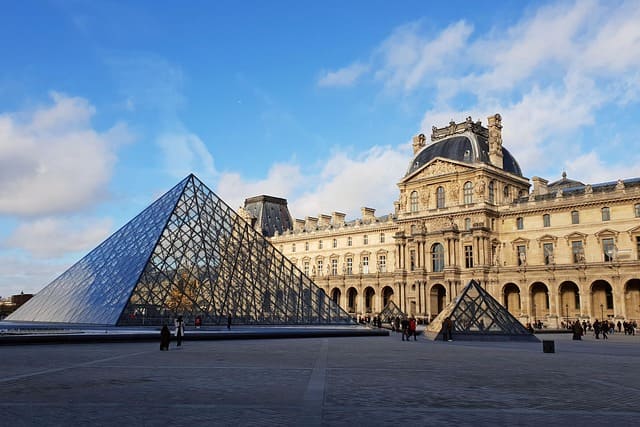The Louvre heist has sent shockwaves through France and the global art community. In an audacious daytime robbery, thieves broke into the Louvre Museum in Paris, escaping with eight priceless pieces of jewelry in under eight minutes.
The stolen treasures, including imperial jewels once worn by Empress Eugénie, are estimated to be worth nearly £10 million ($13.4 million).
The Louvre heist took place on a quiet Sunday morning, when a group of professional criminals infiltrated one of the most heavily guarded museums on Earth. Their target: a jewelry exhibition showcasing pieces of French imperial history.
Within minutes, the robbers smashed display cases, seized the most valuable items, and fled the scene on scooters, disappearing into the streets of Paris before security could intervene.
Table of Contents
Inside the Louvre Heist: How the Operation Unfolded
According to French police, the Louvre heist was executed with military precision. Security footage shows the suspects moving with confidence, suggesting prior surveillance and intimate knowledge of the museum’s layout.
Authorities confirmed that eight significant artifacts were stolen — including diamonds, natural pearls, and gold ornaments — each carrying immense historical and cultural importance. Two smaller items, believed to have been dropped during the escape, were later recovered near the museum grounds.
The speed and efficiency of the Louvre heist have led investigators to suspect the involvement of a highly organized crime network.
Who’s Behind the Louvre Heist?
Dutch art detective Arthur Brand, often referred to as the “Indiana Jones of the art world,” believes the Louvre heist was carried out by professionals with previous experience in high-value art crimes.
“You don’t just wake up and decide to rob the Louvre,” Brand told the BBC. “These thieves have done this before — they were confident, skilled, and knew exactly what to take.”
French prosecutor Laure Beccuau echoed this theory, confirming that investigators are focusing on organized criminal networks known for money laundering and black-market art trafficking. Forensic teams are currently analyzing a vest and specialized equipment left at the scene for possible DNA traces — which could lead to the first major breakthrough in the Louvre heist case.
Why the Stolen Jewels Matter
The jewels stolen in the Louvre heist are not merely valuable; they represent centuries of French legacy. Among them was Empress Eugénie’s tiara, a rare masterpiece featuring natural pearls and flawless diamonds.
Jewelry historian Carol Woolton described the robbery as “a theft of national identity.”
“These were beautiful, historic gems that told the story of France’s imperial past,” Woolton said. “It’s heartbreaking — they’re likely being dismantled as we speak.”
Experts fear the jewels from the Louvre heist will be broken apart, the metals melted down, and the stones cut into smaller, untraceable fragments before being sold through underground markets.
The Aftermath: A National Loss
The Louvre heist has struck a deep emotional chord across France. The Louvre is not just a museum; it’s a symbol of the nation’s artistic and cultural soul.
Alexandre Leger, head of heritage at Maison Vever, captured the nation’s grief in his remarks:
“What was stolen belonged to all of us. It’s as if someone had taken the Mona Lisa. Someone stole France.”
Police continue to search for leads, but as time passes, experts warn the chances of recovering the jewels intact grow slim.
What Happens Next: The Fate of the Louvre Heist Jewels
The black market for stolen art and jewelry is one of the most elusive criminal enterprises in the world. Experts estimate it’s worth over $6 billion annually, and items from high-profile thefts like the Louvre heist often vanish into private collections or are traded for illegal assets.
According to Tobias Kormind, managing director of 77 Diamonds, even dismantled, the stolen gems could be worth millions.
“Larger stones can fetch around £500,000 each,” Kormind noted. “With four or five of that size plus the gold, the total could reach £10 million. The market is liquid — and there are always buyers willing to take the risk.”
The Larger Picture: Security and Symbolism
The Louvre heist underscores a growing problem — the vulnerability of cultural institutions to organized, high-precision crimes. Despite cutting-edge security systems, the theft shows that no museum is completely safe from determined, professional thieves.
The heist also reignites global discussions about protecting cultural heritage and increasing international collaboration between law enforcement agencies such as Interpol, Europol, and national art-crime units.
For France, the Louvre heist is not merely a police case — it’s a matter of pride, history, and identity.
Frequently Asked Questions (FAQ)
What was stolen in the Louvre heist?
Eight priceless jewelry pieces, including diamonds, gold ornaments, and Empress Eugénie’s tiara, were taken from a special exhibition at the Louvre Museum.
How much were the stolen items worth?
The jewels are valued at approximately £10 million ($13.4 million), though their cultural value is considered priceless.
Who carried out the Louvre heist?
Authorities suspect a professional organized crime network specializing in art and jewelry thefts across Europe.
Were any of the stolen items recovered?
Two smaller artifacts were found near the escape route, but the main pieces remain missing.
Can the stolen jewels be recovered?
Experts say recovery is unlikely if the jewels have already been dismantled or resold through the black market.
Conclusion: A Theft Beyond Measure
The Louvre heist represents more than a financial loss — it’s a cultural wound that cuts deep into the French identity.
As detectives race against time to recover the missing treasures, the incident stands as a chilling reminder of how fragile even the most secure sanctuaries of history can be.
Until justice is served, the Louvre heist will remain one of the most haunting chapters in the story of global art crime.
For more investigative coverage and in-depth cultural reporting, visit www.documentarytimes.com
